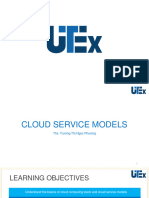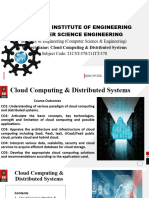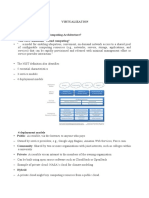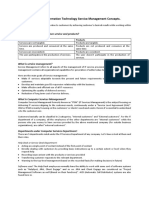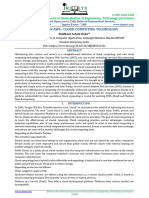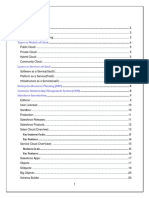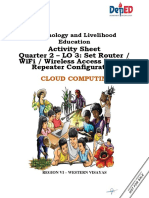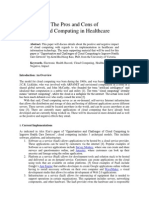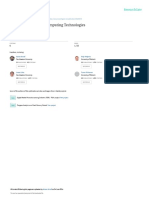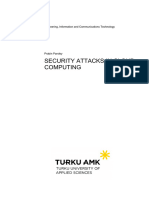VIGNAN INSTITUTE OF TECHNOLOGY & SCIENCE
CONTENTS :
Cloud Service Models:
Infrastructure as a Service.
Characteristics of IaaS.
Suitability of IaaS.
Pros and Cons of IaaS.
Summary of IaaS Providers.
Platform as a Service.
Characteristics of PaaS.
Suitability of PaaS.
Pros and Cons of PaaS.
Summary of PaaS Providers.
Software as a Service.
Characteristics of SaaS.
Suitability of SaaS,
Pros and Cons of SaaS
Summary of SaaS Providers
Other Cloud Service Models.
�Introduction
Cloud computing is a model that enables the end users to
access the shared pool of resources such as compute,
network, storage, database, and application as an on-demand
service without the need to buy or own it.
The services are provided and managed by the service
provider, reducing the management effort from the end user
side.
The essential characteristics of the cloud include on-demand
self-service, broad network access, resource pooling,
rapid elasticity, and measured service. The National
Institute of Standards and Technology (NIST) defines three
basic service models, namely, IaaS, PaaS, and SaaS.
�� The NIST definition of the three basic service models is given
as follows:
1. IaaS: The ability given to the infrastructure architects to
deploy or run any software on the computing resources
provided by the service provider. Here, the underlying
infrastructures such as compute, network, and storage are
managed by the service provider. Thus, the infrastructure
architects are exempted from maintaining the data center or
underlying infrastructure.
The end users are responsible for managing applications that are
running on top of the service provider cloud infrastructure.
Generally, the IaaS services are provided from the service provider
cloud data center. The end users can access the services from their
devices through web command line interface (CLI) or
application programming interfaces (APIs) provided by the
service providers. Some of the popular IaaS providers include
Amazon Web Services (AWS), Google Compute Engine,
OpenStack, and Eucalyptus.
� PaaS: The ability given to developers to develop and deploy
an application on the development platform provided by the
service provider.
Thus, the developers are exempted from managing the
development platform and underlying infrastructure. Here,
the developers are responsible for managing the deployed
application and configuring the development environment.
Generally, PaaS services are provided by the service provider
on an on-premise or dedicated or hosted cloud infrastructure.
The developers can access the development platform over the
Internet through web CLI, web user interface (UI), and
integrated development environments (IDEs).
Some of the popular PaaS providers include Google App
Engine, Force.com, Red Hat OpenShift, Heroku, and
Engine Yard.
�SaaS:
The ability given to the end users to access an application
over the Internet that is hosted and managed by the service
provider. Thus, the end users are exempted from managing or
controlling an application, the development platform, and the
underlying infrastructure.
Generally, SaaS services are hosted in service provider–
managed or service provider–hosted cloud infrastructure. The
end users can access the services from any thin clients or web
browsers. Some of the popular SaaS providers include
Saleforce.com, Google Apps, and Microsoft office 365.
��Deployment and delivery of different cloud service delivery models.
�Infrastructure as a Service
IaaS changes the way that the compute, storage, and
networking resources are consumed.
In traditional data centers, the computing power is consumed
by having physical access to the infrastructure.
IaaS changes the computing from a physical infrastructure to
a virtual infrastructure.
IaaS provides virtual computing, storage, and network
resources by abstracting the physical resources. Technology
virtualization is used to provide the virtual resources.
All the virtual resources are given to the virtual machines
(VMs) that are configured by the service provider. The end
users or IT architects will use the infrastructure resources in
the form of VMs as shown in Figure 5.4.
� The targeted audience of IaaS is the IT architect. The IT
architect can design virtual infrastructure, network, load
balancers, etc., based on their needs.
The IT architects need not maintain the physical servers as it
is maintained by the service providers.
The physical infrastructure can be maintained by the service
providers themselves.
Thus, it eliminates or hides the complexity of maintaining the
physical infrastructure from the IT architects.
A typical IaaS provider may provide the flowing services as
shown in Figure 5.5:
��� 1. Compute: Computing as a Service includes virtual central
processing units (CPUs) and virtual main memory for the
VMs that are provisioned to the end users.
2. Storage: STaaS provides back-end storage for the VM
images. Some of the IaaS providers also provide the back end
for storing files.
3. Network: Network as a Service (NaaS) provides virtual
networking components such as virtual router, switch, and
bridge for the VMs.
4. Load balancers: Load Balancing as a Service may provide
load balancing capability at the infrastructure layer.
��Characteristics of IaaS
IaaS providers offer virtual computing resources to the
consumers on a pay-as-you-go basis. IaaS contains the
characteristics of cloud computing such as on-demand self-
service, broad network access, resource pooling, rapid
elasticity, and measured service. Apart from all these, IaaS
has its own unique characteristics as follows:
1. Web access to the resources:
2. Centralized management:
3. Elasticity and dynamic scaling:
4. Shared infrastructure:
5. Preconfigured VMs:
6. Metered services:











